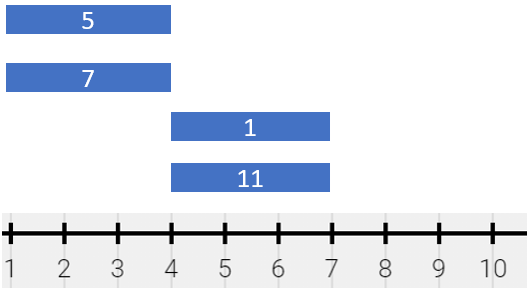Describe the Painting
Problem
There is a long and thin painting that can be represented by a number line. The painting was painted with multiple overlapping segments where each segment was painted with a unique color. You are given a 2D integer array segments, where segments[i] = [starti, endi, colori] represents the half-closed segment [starti, endi) with colori as the color.
The colors in the overlapping segments of the painting were mixed when it was painted. When two or more colors mix, they form a new color that can be represented as a set of mixed colors.
- For example, if colors
2,4, and6are mixed, then the resulting mixed color is{2,4,6}.
For the sake of simplicity, you should only output the sum of the elements in the set rather than the full set.
You want to describe the painting with the minimum number of non-overlapping half-closed segments of these mixed colors. These segments can be represented by the 2D array painting where painting[j] = [leftj, rightj, mixj] describes a half-closed segment [leftj, rightj) with the mixed color sum of mixj.
- For example, the painting created with
segments = [[1,4,5],[1,7,7]]can be described bypainting = [[1,4,12],[4,7,7]]because:[1,4)is colored{5,7}(with a sum of12) from both the first and second segments.[4,7)is colored{7}from only the second segment.
Return the 2D array painting describing the finished painting (excluding any parts that are not painted). You may return the segments in any order.
A half-closed segment [a, b) is the section of the number line between points a and b including point a and not including point b.
Examples
Example 1:

Input: segments = [[1,4,5],[4,7,7],[1,7,9]]
Output: [[1,4,14],[4,7,16]]
Explanation: The painting can be described as follows:
- [1,4) is colored {5,9} (with a sum of 14) from the first and third segments.
- [4,7) is colored {7,9} (with a sum of 16) from the second and third segments.
Example 2:

Input: segments = [[1,7,9],[6,8,15],[8,10,7]]
Output: [[1,6,9],[6,7,24],[7,8,15],[8,10,7]]
Explanation: The painting can be described as follows:
- [1,6) is colored 9 from the first segment.
- [6,7) is colored {9,15} (with a sum of 24) from the first and second segments.
- [7,8) is colored 15 from the second segment.
- [8,10) is colored 7 from the third segment.
Example 3:

Input: segments = [[1,4,5],[1,4,7],[4,7,1],[4,7,11]]
Output: [[1,4,12],[4,7,12]]
Explanation: The painting can be described as follows:
- [1,4) is colored {5,7} (with a sum of 12) from the first and second segments.
- [4,7) is colored {1,11} (with a sum of 12) from the third and fourth segments.
Note that returning a single segment [1,7) is incorrect because the mixed color sets are different.
Constraints:
1 <= segments.length <= 2 * 10^4segments[i].length == 31 <= starti < endi <= 10^51 <= colori <= 10^9- Each
coloriis distinct.
Solution
Method 1 - Sweep line algorithm
The key idea for solving this problem is to merge intervals based on the colors applied and create new non-overlapping intervals with their mixed color sums:
- Use sweep line and sort events to determine the intervals where color changes.
- Events represent a starting or ending of a segment. For each segment
[start, end, color], you add two events:- A start event for
startwithcolor. - An end event for
endto removecolor.
- A start event for
- Traverse the sorted events and keep track of the active colors using a
TreeMapor ordered map in Java and Python. - Whenever moving between events on the number line, output the interval
[left, right)and sum of active color set values. - Finally, return the result.
Code
Java
class Solution {
public List<List<Integer>> splitPainting(int[][] segments) {
// Step 1: Create a TreeMap to store events
TreeMap<Integer, Integer> events = new TreeMap<>();
for (int[] seg : segments) {
int start = seg[0], end = seg[1], color = seg[2];
// Start event
events.put(start, events.getOrDefault(start, 0) + color);
// End event
events.put(end, events.getOrDefault(end, 0) - color);
}
// Step 2: Process events to construct intervals
List<List<Integer>> ans = new ArrayList<>();
int prev = -1; // Previous position on the number line
int currSum = 0; // Current sum of colors
for (Map.Entry<Integer, Integer> entry : events.entrySet()) {
int pos = entry.getKey();
int color = entry.getValue();
// If we are moving to a new position in the number line
if (prev != -1 && currSum != 0) {
ans.add(Arrays.asList(prev, pos, currSum));
}
// Update sum of colors
currSum += color;
prev = pos;
}
return ans;
}
}
Python
class Solution:
def splitPainting(self, segments: List[List[int]]) -> List[List[int]]:
# Step 1: Create a list of events
events = []
for s, e, c in segments:
events.append((s, c)) # Starting event
events.append((e, -c)) # Ending event
# Step 2: Sort events by position
events.sort()
# Step 3: Process events to construct intervals
ans = [] # Final result
prev = None # Previous position
curr_sum = 0 # Current sum of colors
for i in range(len(events)):
pos, color = events[i]
# If we are moving to a new position in the number line
if prev is not None and pos != prev:
# Add interval to `ans` if the sum is non-zero (paint exists)
if curr_sum != 0:
ans.append([prev, pos, curr_sum])
# Update sum of colors
curr_sum += color
prev = pos
return ans
Complexity
- ⏰ Time complexity:
O(n log n)- Sorting the events:
O(n log n), wherenis the number of segments. - Traversing events and managing active colors:
O(n). Overall complexity isO(n log n).
- Sorting the events:
- 🧺 Space complexity:
O(n)for storing events and active colors.